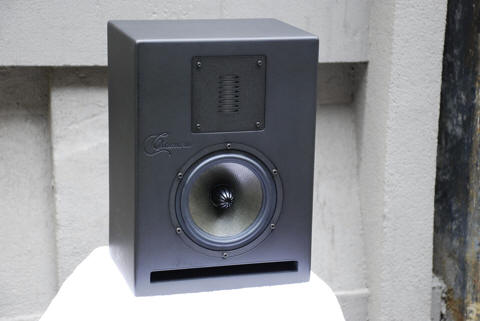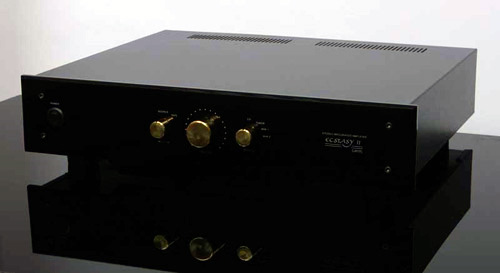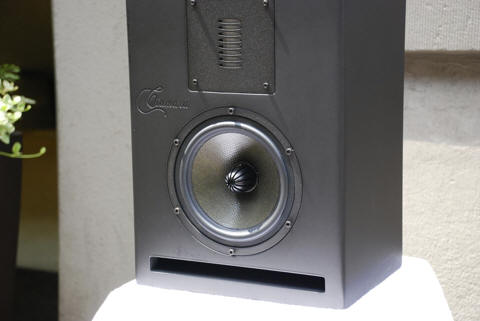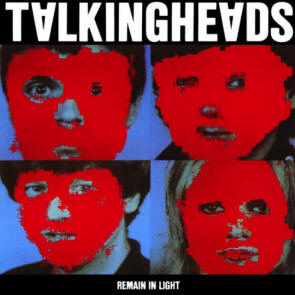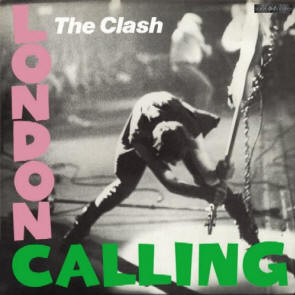|
You are reading the older HTML site
Positive Feedback
ISSUE
52
Ciamara Elegance Series 1 (ES1) 2-Way Loudspeaker
We've all heard it. The "gotcha" line spit out by the audio budgeter outraged at the price of something or other. "Yeah, but is it worth five times the cost?" In these situations, I usually counter with, "Well, if a car costs four times as much as a cheaper model, do you expect it to be four times bigger or faster?" No, as with most things in life, higher costs can only deliver incremental improvements, but those differences can substantially alter the satisfaction of the experience. I bring all this up because I'm currently awash in stand-mount speakers of varying price and performance, starting at the low end, with my new pair of Pioneer SP-BS21-LR 4" 2-Way Bookshelf Speakers ($80, on sale), an old pair of Tannoy Eyris 1s ($900), the current fave Nola Boxers ($1499), and the brand new Ciamara Elegance Series 1 (ES1) 2-Way Loudspeaker ($7990 a pair or $3995 each). If a little knowledge is a dangerous thing, then the initiation to the ever unfolding improvements in audio satisfaction is positively devastating... to my 401K. If I didn't know what was available goin' up the crystal stair, then the little Pioneers—created by famed speaker designer Andrew Jones—deliver ridiculously good sound for the money (for more on Andrew Jones, check out Dave Clark's interview in Issue 30 of PFO... www.positive-feedback.com/Issue30/andrew_jones.htm). But even I know that a great design requires a modicum of high quality parts to make it realize its potential. Not surprisingly, then, the Pioneers are not the equal in frequency range, tonal accuracy, or soundstage of the Tannoys, just as the Tannoy's are bested in these qualities (and sense of spaciousness) by the Nolas. The differences in sound aren't as great as the price points, but each subtle graduation from model to model changes the quality of musical reproduction enjoyed by the listener. The ES1s, then, at nearly 100 times the cost of the bargain basement Pioneers are not necessarily 100 times better, but the improvement in the listening justifies the price. As we all know, "better" in the realm of high end audio quickly lies in the province of faith, not facts. But I can confidently assert that the Ciamara's provide a completely different audio experience than the other speakers in my collection. Simply a step up in class, and that's all there is to it. So what does my (well not my, exactly, but maybe yours) eight grand get me? First off, you get a two-way loudspeaker with an air motion ribbon tweeter and a seven inch hexacone bass with phase plug, sporting a frequency range of 40Hz - 25kHz, and a sensitivity rating of 89dB/W (1m). Next, you need to know that this seemingly mild-mannered monitor has a recommended amplifier power rating of 150W at 8 ohms, so don't be afraid to take the cover off whatever mean machine is lurking in your listening room. These speakers are designed for adequate power, and even though the manufacturer's assurance and my own experience showed that they could still provide plenty of excellent sound at lower levels, I suspect that still cheats them of their best performance. But we're talking about music, not muscle cars, so power ratings and specs are pretty useless unless the ES1s can make my collection sparkle in a way that other speakers don't. My initial impressions were that, though they were a touch bright, it was not at all unpleasant. As I settled in, I realized that what they really are is resolving, something that became really enjoyable to listen to as time went on. This establishes a pattern where a seeming weakness, upon further listening and education to a more sophisticated sound, is in actuality a sign of high quality. So let's pluck a card from the instrument deck, and, hey, it turns up PIANO. I love using piano to measure my enjoyment of monitor speakers. The instrument has a universal recognition and appeal—I've never heard anyone say "The piano gives me a headache"--and a good piano sound is a helluva thing to pull off. That distance between the ES1s and other speakers is measured by the believability of the sound of this instrument, and the ES1s set themselves off by a good stretch. The speed and decay of the notes, the resolution of the piano as it was recorded in studio, the conveyance of every minute frequency coherently and accurately so as to emerge as that singular sound we call a piano tone: all are part and parcel of tricking your brain into believing that a piano is somewhere behind the ES1s on the stands. Moreover, the ES1s do not produce the same level of artifacts, frequency roll off, slightly artificial bump to color the sound that you find in the Nolas, the Tannoys, and the Pioneers. And, again, these speakers are all favorites of mine in their respective "classes," so the added presence and solidity of the notes within the spectrum as conveyed by the ES1s should be seen as a sign that the additional expense was spent on high quality parts and not glossy ads. To illustrate, Elton John's "Rotten Peaches," from Madman Across the Water, features lots of reverb on slide guitar, conga, and piano, and vocal harmonies. In the song's chorus, Elton's vocal line is doubled by full choir, all of it again drenched in reverb and delay. It's easy for a pair of speakers to muddy the thing up so as to be nearly impossible to listen to. The superior resolution and slightly forward edge of the ES1s, however, reproduces the recording in a way that still conveys musicality while avoiding the onset of listener fatigue. Continuing on, the ES1s handling of low frequencies on Gorillaz's "Demon Days" from El Manana, produces bass that is tuneful, but not all enveloping. This is not a sound that will be to everyone's taste, especially those who enjoy speakers voiced to accentuate, say, the bottom note on a stand up bass, but the lower frequencies that are there are reproduced with proper solidity. They ain't bombastic fantastic, though, so Rick James superfreaks will need a boomier box. On the Gorillaz track, the smooth handling of the synth drum truck enables the drum track to support the rhythmic structure without the typically annoying harshness that monitors often produce when faced with purposely distorted and reverberated drum machines. Lastly, on "The Sea and Cake" from Black Tree in the Bee Yard by The Fawn, a synthesizer lays down ambient background, while a steady four note repeating electric guitar pattern (played by a guitar pick scraping the strings at an angle) provides the counterpoint. The edge of the pick is articulated but not overemphasized, as it would be if the speaker were too forward or resolving. If it were, then the brief entrance of a second electric guitar playing high accent notes would be jarring, instead of as a piece. These brief examples illustrate the high quality of the Ciamara ES1s. The main caveat that I encountered was that the ES1s don't go as low as I would like them to, but, then again, they also avoid the artificial boom found in less proficient monitors. Furthermore, I suspect that these speakers would really come alive with more substantial amplification than the Virtue Audio Sensation or Arcam A-80 were able to muster up. Still, there's no doubt that these are really beautiful sounding speakers, and fine examples of what can be accomplished when one starts moving up to the higher end of the audio spectrum. Dean Seislove Truth be told, my copy here was intended to compliment Dean Seislove's comments rather than to be my notes on a design I was already interested in. So, consider my comments here impressionistic rather than a "review." Ciamara. Not a name I've heard before. Small speakers, big price. Hmmm. Sounds like trouble. I'm not going to spray a corporate biography on you here, just draw a picture of what Ciamara offers and my thoughts. I can't tell whether Ciamara's market is the recording industry or the consumer market, as their designs seem purist before they seem consumerist, no slam intended. The speakers are boldly simple with no grill covers, leaving drivers exposed, for better or worse. Yet, Ciamara offers their speakers in a very broad range of solid colors as well as natural wood and "exotic" wood finishes, so buyers can acquire a speaker in nearly any color or wood finish they might want. The ES-1 on call today is their "entry level" speaker that retails for $3995 each, rather than $7990 a pair. I suppose that positioning cushions the blow of the cost. It's the entry speaker in the "Elegance line," counterposed to Ciamara's top "Reference" line. Ciamara's top of the line, the Reference lines RS4, is a four way active speaker whose cost dwarfs the ES-1 at $79,990 each; leaving you with a choice of speakers or for just a bit more money a 2010 Bentley Continental Flying Spur? At $177,000 the Bentley... well, it's a Bentley. Anyway, though audio prices are migrating toward the moon, someone is paying these prices so it doesn't deserve too much attention, but it merits notice, nonetheless. It also suggests serious intentions, as well. The ES-1s, unlike their Reference Line speakers are not active, so you'll have to bring your own amplifier. Some Details The ES-1s do not come with a grill cover, nor does one appear to be available. So in the middle of a seven inch hexacone woofer you'll be looking at the Jimmy Durante of phase plugs. It's substantial. The woofers are directly above a rectangular port that may evidence a transmission line port. The review pair were finished in a luxurious solid black matte color that seemed scratch resistant, though somehow the bottoms arrived scratched. Excepting for the phase plug, the speakers are visually appealing and nicely finished, and.... the phase plug is simply, big. No getting around that. Some Background Since I have powered speakers, I needed to borrow an amplifier to listen to the ES-1s. I recently received the Dayens Ecstasy II integrated from Serbia. It's a solid state line level integrated producing 70 watts into eight ohms and 90 watts into four ohms. In order to calibrate the sound of the Dayens, I borrowed what were my second system speakers, but now reside at my brother-in-law's house, a pair of ATC SCM7s, a very small, but power hungry speaker. ATCs are all "timbre matched" per ATC and by my own experience as well, so if the Dayens went sideways driving the 7s', I think I'd notice.
The Dayens seems to be quite a nice little integrated; my notes on it will come soon. The SCM 7s sounded like they ought through a solid state integrated amplifier. Due to the SCM 7s lowish 84 dB sensitivity the Ecstasy needed to be turned up to turn the SCM7s on (oh! and I didn't have to pay to be able to write that!). Or, in plainer language, the SCM7s, like most underpowered speakers needed more volume to come alive with the Ecstasy. When underpowered and at lower volume levels a speaker can sound either a bit lifeless and/or soft in the bottom end. This is normal in my experience. Some Listening Initially the ES-1 did not favorably impress. The tonal balance seemed a bit light and bright, the antithesis of what I prefer. I grew up listening to live music in a well damped room (lots of heavy curtains and carpet), and that's the yard stick I always bring with me. So, initially after hearing them in my room I almost declined to write about the ES-1s. Dean indicated that the speakers grew on him and so I thought, perhaps this is the rare audio product that grows on me. Rather than take you through my metamorphosis or outline every track I listened to, I'll just cut to the quick.
The ES-1s plumb to around 40Hz, which seems pretty extraordinary given the small size (16" tall) and weight of the speakers (38 Lbs). Bass is tight, controlled and not bloomy, at least in my system. But my reference to "light and bright" here referred to the timbre—it seemed to miss a bit of warmth and fullness and was just a bit cool and emotionally light in impact. Still, its bass presentation was deep enough to allow me to enjoy Reference Recordings' 30th Anniversary Sampler. And, that sampler ended up the gateway to experiencing the ES-1s. Something Change My wife is a "la la listener," meaning, whether her ears are better than mine or not, she sips "nice" music rather than having a thirst for it. So I call her a "la la listener." We listen to a lot of Pink Martini, rather than some of the roots music or other slutty loud music I also like. I, on the other hand, have a thirst for music. For me listening is more like "Yeah! Yeah! Get wound up," "celebrate" or get really quiet and intense about having a listening session. If no one is home, I like the volume up to compensate for the times when I have to listen at Starbucks levels, and I tend to dig out unpopular gems like Talking Heads' Remain In Light, the Clash's London Calling, and other stuff my wife and I don't agree on. Otherwise, that music gets frowns from Ms. La La.
I stayed home "sick" one day while the ES-1s were here. Well, truthfully, I wasn't sick but just coughing so much I really couldn't carry on a conversation, so I played hooky for a couple of days. Initially I put on the 30th Anniversary Sampler while I was working hard at Super Mario Galaxy on our new Wii. It's totally embarrassing and true. I got distracted from the game because of the music, specifically John Tavener's Ikon of Eros, a piece that is a mix of loud, sustained periods of quiet and is surprisingly eerie and spiritual in experience. So I cranked up the volume on the Ecstasy and put Mario into sleep mode for a while. In fact, Mario was pushed aside for the rest of my convalescence while I decided to examine what the ES-1 could do. Reference Recordings' sampler is more the fireworks of the Clash than the sweetness that Pink Martini is. The ES-1s got my attention and benefited by me being alone with music at relatively high volume levels. With that twist of the knob, I found my appreciation for the Ciamaras had turned as well. For context relatively high volume means that my wife would be objecting, whether seated next to me or in the adjacent kitchen. But, this volume level is barely approaching a live event. Something in the Way You Move... The Ciamara ES-1s are rated as 89dB efficient, which should mean that they'd require a small fraction of the power the SCM 7s needed to come to life (perhaps 1/16th?). However, Ciamara recommends 150 watts per channel for the ES-1s. With this in mind, I would expect the same sort of result as the SCM 7s with the ES-1s. I didn't have more watts on hand, so my comments are potentially skewed. Keep in mind, then, that the optimal amplifier was not matched to the ES-1s and louder volume might well be the solution. The Reference Recordings sampler was a pleasure through the ES-1s, with remarkable bass coming through in tracks three and four, Gabriela Frank's "Three Latin American Dances For Orchestra" and J.S. Bach's "Fantasie & Fuge uber das Thema B-A-C-H", for piano. Both are really thrilling recordings of exciting music with lots of bottom end. Bass through the ES-1s on these was well textured, not the least bit bloomy and quite tight all around. Good marks here and quite a surprise for such a small speaker. The ES-1s presentation was pretty special, especially for a sixteen inch high, thirty-eight pound speaker. The sound was composed at all volume levels and though I didn't try to get the speaker to breakup, it never did. The dynamics and quiet of Ikon of Eros were well portrayed here and the experience was a very special one for me. I also found myself spiritually lifted out of my seat on this track, an emotionally compelling and striking sounding piece. The Ciamaras are the first speaker that had me listen all the way through that track. Well done, Ciamara. ATC speakers have a deserved reputation for resolution and detail; they're among the most popular speaker lines in high end recording studios. From experience I'll say ATC's active speakers (my reference) exhibit even more resolution and detail than their passive speakers do. My powered speakers retail for about $8300, a little more than the ES-1s, but the ATCs come with four built-in amplifiers totaling 500 watts and two active crossovers. Few people would say ATCs are a diffuse sounding speaker, certainly not I. Yet, I think the ES-1s might be a bit more resolving than my reference. They certainly resolved really well at lower volume levels and better than the SCM 7's, though it is harder to say with regard to the performance of my reference speakers. My powered ATCs were also partnered to a relatively expensive tube preamp and system wiring that doesn't cool the sound. It's been my experience that cool or "bright" sounding gear appears to be more detailed. To figure out how good the ES-1s were, I connected my turntable to the Dayens integrated and wiring by use of my E.A.R. 864 preamp. As a line level amp, the Dayens has no phono section, so my E.A.R. 864 entered the picture here. My analog setup is superior to my digital setup, so that means my comments about the ES-1s with vinyl aren't necessarily in line with how my system sounded with only the Dayens in the amplification path. For this part of the review I hauled out a different variety of analog recordings to hear through the ES-1s. Among the "test pieces" were Frank Sinatra's "Songs for Swinging Lovers," as well as a pair of mint reissues, namely Duke Ellington and Johnny Hodges' Side by Side, and Duke Ellington's pairing with Louis Armstrong on Recording Together for the First Time. None of the three are as detailed or dynamic as Reference Recordings' Sampler; instead they bear a mellower listening experience that features more sustained tones than attack, decay and macro-dynamics. Also, these recordings don't call for higher volume levels. If the digital sampler was big, fast and dynamic as a way to show off attack, decay and macro-dynamics, the LPs were more about understated, quiet and intimate recordings. While pace might be something to attend to here, the music here is not a sort of rhythmic propulsion, so much as the gentle cajoling of an inobvious rhythm. With these generally warm jazz LPs a bit of the light and bright impression of the ES-1s resurfaced for me. The ES-1's seemed a cooler and less relaxed presentation than my reference. Both the much less expensive ATC SCM7s and SCM20-2A speakers seemed to do warm and relaxed a bit better than the ES-1s. With the Ciamaras, Sinatra's voice had a bit of impatience to it, there seemed to be a bit more urgency to both of Ellington's pairings than I recalled. My wife the la la listener, on the other hand, preferred the ES-1s on these LPs. Go figure. So, for this listener, I found the Ciamara ES-1s a bit more insistent than I wanted or thought was 100% natural on these three recordings. Whether or not my reference system is balanced on the edge of analytical, it certainly does not hew to romantic; but in this case it was more relaxed sounding than the ES-1s. How do I explain this? Perhaps this is how not enough power from the Dayens Ecstasy manifested with the Ciamara ES-1s. Had I played the Dayens louder, maybe it's power shortage would have been hidden, but that would have made the playback level "inappropriate" to the kind of music being played. Please keep in mind, it would be an exaggeration to say that the ES-1s didn't play this music well, I'm merely making a comparison of two similarly priced speakers and found a preference. Ciamara is a new company to me. Their ES-1 suggests that Ciamara's principals know what they're doing. Their smallest speaker credibly reproduces large scale classical music very well. In my system, they seemed to favor, big dynamic, "fast" sounding tracks, and certainly the Reference Recordings' Sampler was exactly what the doctor ordered. The ES-1's timbre initially seemed a bit light in weight, but over the long haul, I found it a very attractive performer. I withdraw my initial impression and say I like them quite a bit. Sonically, in my system with perhaps insufficient power the ES-1s didn't play quieter as well as they played music with a dynamic swing played back at high levels. This probably points to insufficient power, though I cannot guarantee it. In my admittedly "wrong system" the ES-1s drove more like a dragster than providing the luxury ride of a Bentley. Still, the ES-1 is a strong performer. Some might balk at the high price for a small speaker, but the Ciamara ES-1s seem to be priced in the ball park for their performance. Larry Cox Ciamara
|

